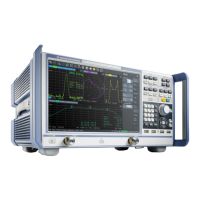Concepts and Features
R&S
®
ZNB/ZNBT
119User Manual 1173.9163.02 ─ 55
)Re(
)Re(
1
0
0
1
10
0
i
i
i
i
ii
i
ii
Z
Z
Z
Z
ZZ
Z
P
2. Power waves
In the model of Kurokawa ("Power Waves and the Scattering Matrix"), the wave
quantities a and b are transformed as follows:
i
i
iiii
iiii
ii
i
i
b
a
ZZZZ
ZZZZ
ZZ
b
a
0
0
1010
1010
10
1
1
)Re()Re(2
1
The renormalized S-matrix S1 is calculated as:
ASESAS
1
00
1
1
with the unit matrix E and two additional matrices with the elements
ii
ii
ii
ZZ
ZZ
01
01
iiii
ii
ii
ii
A
1
1
1
5.3.3 Impedance Parameters
An impedance is the complex ratio between a voltage and a current. The analyzer pro-
vides two independent sets of impedance parameters:
●
Converted impedances (each impedance parameter is obtained from a single S-
parameter)
●
Z-parameters (complete description of an n-port DUT)
5.3.3.1 Converted Impedances
The converted impedance parameters Z
ij
(1 ≤i,j ≤n) describe the input impedances of
an n-port DUT with fully matched outputs. The analyzer converts a single measured S-
parameter S
ij
to determine the corresponding converted impedance, under the
assumption that each of the other ports is terminated with its respective reference
impedance Z
0k
(matched-circuit parameters). As a result, converted impedances can-
not completely describe general n-port DUTs.
The extension of the impedances to more ports and mixed mode measurements is
analogous to S-parameters. Z
dd44
is the differential mode input impedance at port 4 of a
DUT that is terminated at its other ports with the reference impedance Z
0
.
The Converted Admittances are defined as the inverse of the converted impedances.
Measurement Results

